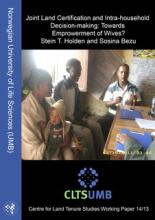Land Library Search
Through our robust search engine, you can search for any item of the over 73,000 highly curated resources in the Land Library.
If you would like to find an overview of what is possible, feel free to peruse the Search Guide.
/ library resources
Showing items 1495 through 1503 of 1573.This paper is about land tenure relations among the matrilineal and patrilineal cultures in Malawi. Data from the National Agricultural and Livestock Census are used to characterize marriage systems and settlement and landholding patterns for local communities.
We have used gender-disaggregated household panel data from 2007 and 2012 in combination with dictator games and hawk-dove games to assess the effects of joint land certification of husbands and wives on wives’ involvement in land-related decisions within households.
The study uses five rounds of household panel data from Tigray, Ethiopia, collected in the period 1998–2010 to assess the impacts of a land registration and certification program that aimed to strengthen tenure security and how it has contributed to increased food availability and thus food secur
Ethiopia has implemented one of the largest, fastest and cheapest land registration and certification reforms in Africa.
This article provides a review of the past and potential future roles of land tenure reforms and land markets in Sub-Saharan Africa (SSA) as responses to population growth in the process of land use intensification and livelihood transformation.
Targeted illegal harvesting of hardwood in the woodland of Namibia’s Kavango region threatens forest stands. In a transforming setting, where wood is increasingly traded through value chains on a globalized market, local harvesters have complex incentives but also a crucially important position.
The island of La Gonave lies northwest of Port-au-Prince and is representative of the subsistence Haitian lifestyle. Little is known about the land cover changes and conversion rates on La Gonave.
The paper analyzes land use changes, notably cropland expansion, in SE-Niger from the mid-1980s to 2011.
Landscape changes and the processes driving them have been a critical component in both research and management efforts of savanna systems.






